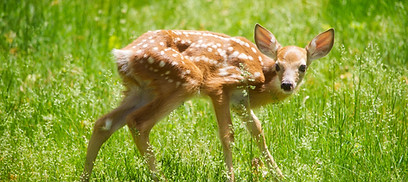Female deer, known as does, give birth to their fawns in late May/early June. The doe then deliberately leaves her fawns alone to protect her infants. For the first two weeks, newborns have no scent and cannot be found by predators, unlike mom, whose scent may attract a predator to her baby.
The fawns have a wonderful camouflage - their natural spotted coloring - for their defense and it's normal for a fawn to "freeze" when approached. Even the best rehabbers have practically tripped over the fawn they've been told has been orphaned while looking for them in the woods.
The doe, while well hidden, is most often still nearby watching her baby. She will come back a couple times a day to feed her fawns, but she nurses quickly and it's unlikely you would ever see her. It breaks our hearts to know how often a fawn is picked up by a well intentioned but ill-informed person and the doe is watching, helpless to stop what is happening to her baby.
It's important that the fawns be left alone. The doe will move them when she knows they're ready. If they are in harms way, it is OK for you to move them a few yards away from danger, but then leave them alone. The doe can easily find her babies. If you come across an infant fawn curled up like a cat sleeping, not crying, and no sign of a dead mother, you need to leave that baby alone.
On the rare occasions a fawn is truly orphaned, these signs will be obvious:
-
Non-stop crying
-
Indentations above eyes
-
Feces on rear
-
Maggots
-
Cuts or broken bones
-
Cold mouth
-
Unusually friendly toward people
